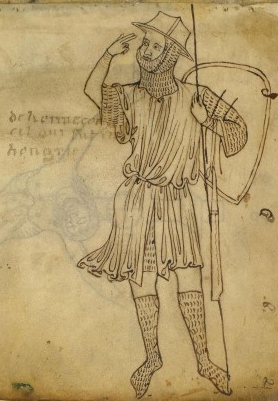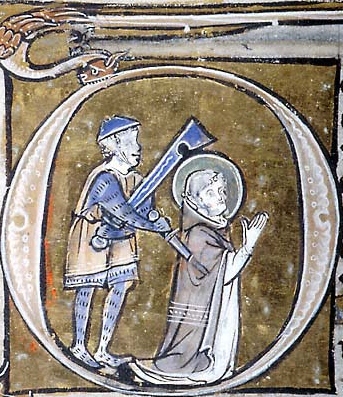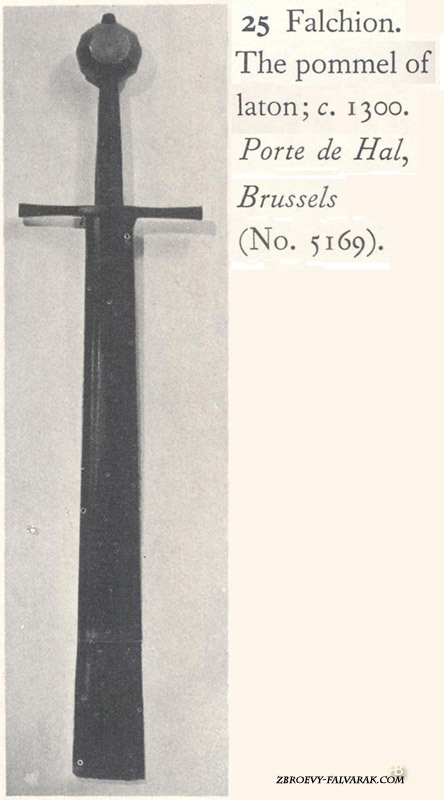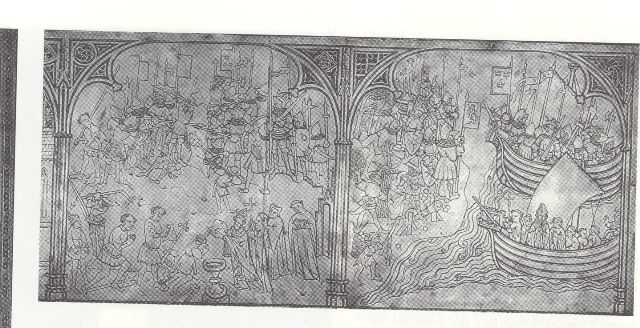This:
http://www.medievaltymes.com/courtyard/images...etail4.gif
[ Linked Image ]
What would you call it? An early Falchion?
(I'm asking because I bought a reproduction for re-enactment use and calling it a 'chopper' just doesn't seem right)
These are usually called a "Maciejowski Falchion" or "Maciejowski chopper". AFAIK, the Maciejowski Bible is the only source, with no physical examples.
"Mac falchion" is a good short working name.
"Mac falchion" is a good short working name.
the only one close enough, I know off ,is this one , it has been auctioned by Czerny's
best,
 Attachment: 119.72 KB
Attachment: 119.72 KB
[ Download ]
best,
[ Download ]
| Timo Nieminen wrote: |
| These are usually called a "Maciejowski Falchion" or "Maciejowski chopper". AFAIK, the Maciejowski Bible is the only source, with no physical examples.
|
Something more or less similar appears in pictorial sources from time to time, but there's indeed no actual find, AFAIR.
http://www.myArmoury.com/talk/viewtopic.php?t=927
[ Linked Image ]
I can't help but wonder if that's some sort of agriculture tool-something like a billhook, or an early machete.
I remember a picture of a statue of a knight carrying something like that. I don't know when the statue was made or if it was meant to be representative of a contemporary knight or an interpretation of a knight from an earlier time. However, artists usually didn't make things up totally of whole cloth.
Nicolle lists an unknown weapon of this time being listed as a fausart or fauchard. There are other manuscript examples, and the cusping is not unusual on 13th century table knives.
[ Linked Image ]
 Attachment: 99.06 KB
Attachment: 99.06 KB

 Attachment: 178.73 KB
Attachment: 178.73 KB

[ Linked Image ]


Looks agricultural to me. For example, suger cane cutters use the same blade.
Museum Replicas had a Maciejoskie line several years back. They made one of these and one of the big butter knife looking swords, and a couple of other weapons from the Bible. I don't know if anyone would have any of them in stock anywhere or not, if you were interested in owning one like it...
Del Tin has made a few of these. Kult of Athena used to sell them at least.
KoA has a few of the Del Tin versions in stock.
[ Linked Image ]
http://kultofathena.com/product.asp?item=DT5134
[ Linked Image ]
http://kultofathena.com/product.asp?item=DT5133
[ Linked Image ]
http://kultofathena.com/product.asp?item=DT5134
[ Linked Image ]
http://kultofathena.com/product.asp?item=DT5133
I bought it from this guy:
http://www.berbekuczviktor.hu/angol/angol.html (under Gothic Swords --- Series) - seems I can't provide a direct link.
I'm not sure about them being agricultural as I noticed a 'feature' which seems to be too co-incidental not to have been designed.. When messing around with it and bearing in mind the discussions here on hammer vs handshake grip, it seems that using a handshake grip on the handle where the curve starts lets you angle the weapon downwards slightly from the angle of your arm (when doing a downward strike). As well as being handy to 'angle' around a shield, it had the effect of making the weapon contact it's target right on the point protruding from the blade-side. It was also ankled perfectly so that the point struck the target with all of the weight from the large mass of steel behind it going directly through that point.
http://www.berbekuczviktor.hu/angol/angol.html (under Gothic Swords --- Series) - seems I can't provide a direct link.
I'm not sure about them being agricultural as I noticed a 'feature' which seems to be too co-incidental not to have been designed.. When messing around with it and bearing in mind the discussions here on hammer vs handshake grip, it seems that using a handshake grip on the handle where the curve starts lets you angle the weapon downwards slightly from the angle of your arm (when doing a downward strike). As well as being handy to 'angle' around a shield, it had the effect of making the weapon contact it's target right on the point protruding from the blade-side. It was also ankled perfectly so that the point struck the target with all of the weight from the large mass of steel behind it going directly through that point.
I've read of weapons of this ilk translated into English as "Cleaver" and the name has always resonated with me as appropriate.
Also I've always thought this weapon was an interesting halfway point between the Maciejowski Cleavers and cruciform hilted falchions, sort of a missing link. Maybe their origin was agricultural but with modification their use in warfare became apparent?


Dan,
Even if it started in agriculture many of these items became full fledged weapons of war, flails, bills, axes, etc. I think the ones that have the many extra cutting facets and spikes are far to elaborate for agricultural work.
Timo,
It is not the only one by a long shot, these show up all over Europe.
Here is one from Finland in 1380.
top left and top right.
RPM
 Attachment: 68.84 KB
Attachment: 68.84 KB

Even if it started in agriculture many of these items became full fledged weapons of war, flails, bills, axes, etc. I think the ones that have the many extra cutting facets and spikes are far to elaborate for agricultural work.
Timo,
It is not the only one by a long shot, these show up all over Europe.
Here is one from Finland in 1380.
top left and top right.
RPM

Page 1 of 1
You cannot post new topics in this forumYou cannot reply to topics in this forum
You cannot edit your posts in this forum
You cannot delete your posts in this forum
You cannot vote in polls in this forum
You cannot attach files in this forum
You can download files in this forum
All contents © Copyright 2003-2006 myArmoury.com — All rights reserved
Discussion forums powered by phpBB © The phpBB Group
Switch to the Full-featured Version of the forum
Discussion forums powered by phpBB © The phpBB Group
Switch to the Full-featured Version of the forum